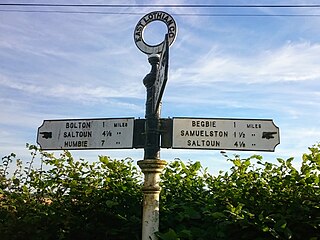
East Lothian is one of the 32 council areas of Scotland, as well as a historic county, registration county and lieutenancy area. The county was called Haddingtonshire until 1921.

Lothian is a region of the Scottish Lowlands, lying between the southern shore of the Firth of Forth and the Lammermuir Hills and the Moorfoot Hills. The principal settlement is the Scottish capital, Edinburgh, while other significant towns include Livingston, Linlithgow, Bathgate, Queensferry, Dalkeith, Bonnyrigg, Penicuik, Musselburgh, Prestonpans, North Berwick, Dunbar, Whitburn and Haddington.

The River Tyne is a river in Scotland. It rises in the Moorfoot Hills in Midlothian near Tynehead to the south of Edinburgh, at the junction of the B6458 and the B6367. It continues approximately 30 miles northeast, and empties into the North Sea near Belhaven.

The Royal Burgh of Haddington is a town in East Lothian, Scotland. It is the main administrative, cultural and geographical centre for East Lothian. It lies about 17 miles east of Edinburgh. The name Haddington is Anglo-Saxon, dating from the sixth or seventh century AD when the area was incorporated into the kingdom of Bernicia. The town, like the rest of the Lothian region, was ceded by King Edgar of England and became part of Scotland in the tenth century. Haddington received Burgh status, one of the earliest to do so, during the reign of David I (1124–1153), giving it trading rights which encouraged its growth into a market town.

East Lothian is a constituency in Scotland which returns one Member of Parliament (MP) to the House of Commons of the Parliament of the United Kingdom, elected by the first past the post voting system.

Tranent is a town in East Lothian, in the south-east of Scotland. The town lies 6 miles from the boundary of Edinburgh, and 9.1 miles from the city centre. It lies beside the A1 road, the A1 runs through the parish splitting the parish from its associated villages and hamlets namely Meadowmill and the port of the parish Cockenzie. The original main post road ran straight through the town until the new A1 was built. Built on a gentle slope, about 90 metres (300 ft) above sea level it is one of the oldest towns in East Lothian. The population of the town is approximately 12,140, an increase of over 4,000 since 2001. Tranent was formerly a major mining town, but now serves as a commuter town for Edinburgh.

Thomas Hamilton, 1st Earl of Haddington, designated before his peerage as 'of Drumcarny, Monkland, and Binning', was a Scottish administrator, Lord Advocate, judge, and Lord Lieutenant of Haddingtonshire.

Abbeyhill is an area of Edinburgh, the capital of Scotland.

Prestonpans is a small mining town, situated approximately eight miles east of Edinburgh, Scotland, in the Council area of East Lothian. The population as of 2020 is 10,460. It is near the site of the 1745 Battle of Prestonpans. Prestonpans is "Scotland's Mural Town", with many murals depicting local history.

Haddington Athletic Football Club are a Scottish football club based in Haddington, the county town of East Lothian. Nicknamed the Hi-His, the club were founded in 1939 and play their home matches at Millfield. The team competes in the East of Scotland League Premier Division, having moved from the junior leagues in 2018.

Morham, East Lothian, sometimes spelt Moram, Morum, or Morhame in old records, is the smallest (agricultural) parish in Scotland, sandwiched between five other parishes: Haddington, Garvald, Yester, Whittingehame, and Prestonkirk, in the undulating lower reaches of the Lammermuir Hills.
Nunraw is an estate in East Lothian, Scotland. It includes the White Castle, a hillfort, situated on the edge of the Lammermuir Hills, two miles south of the village of Garvald, Nunraw House was formerly used as the Guesthouse for retreatants at Sancta Maria Abbey the Cistercian monastery on the hillside nearby. Sir James Balfour Paul, Lord Lyon King of Arms, writing in 1905 stated that Whitecastle and Nunraw are the same place and that the lairds there were often referred to by one or the other of these territorial designations.

Tranent Juniors Football Club are a Scottish football club based in the town of Tranent, East Lothian. The team was promoted from the East of Scotland Football League Premier Division to the Lowland League in 2022, having moved from the junior leagues in 2018. Despite leaving the junior leagues, the club has retained the term "Juniors" as part of their identity. Their home ground is Foresters Park and club colours are maroon and white.

The Collegiate Church of St Mary the Virgin is a Church of Scotland parish church in Haddington, East Lothian, Scotland.

Ballencrieff Castle, also known as Ballencrieff House, is a large tower house at Ballencrieff, East Lothian, Scotland. It is located three miles north west of Haddington, and one mile south of Aberlady.
Hamilton House, also known as Magdalen's House, is a 17th-century "Laird's House" in the town of Prestonpans in East Lothian, Scotland. It is an exemplar of this type of architecture and has retained its crow-stepped gables and corner towers. It is owned by the National Trust for Scotland and is a Category A Listed Building.

Gladsmuir is a village and parish in East Lothian, Scotland, situated on the A199 and near Tranent and Prestonpans.

The family name Begbie originates in south-east Scotland, where it is most common in the Edinburgh and East Lothian areas.
The Palace of Haddington was a 12th–13th-century royal palace in Haddington, East Lothian, Scotland. The palace stood in King Street, on the site of the present East Lothian Council buildings. Remains of the vaulting of the palace were found in 1833, during excavations.

Amisfield House was a substantial Palladian mansion near Haddington, East Lothian.

















